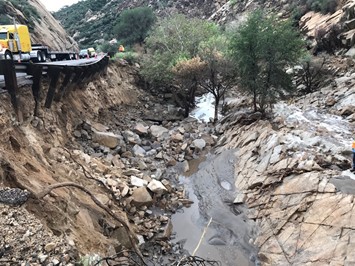PHOENIX – With the National Weather Service forecasting additional monsoon storms in Arizona, drivers should exercise extreme caution and consider ways to avoid severe conditions on the state’s highways and roads. That includes delaying travel until severe weather has passed.
The National Weather Service has noted that wet ground conditions already exist from recent rain, allowing for more rapid flash flooding from new storms this week. With the ground heavily saturated, even small storms have added potential to produce flash flooding or other dangerous conditions. Runoff from storms can send debris, including large rocks or boulders, onto highways and local roads.
The Arizona Department of Transportation says drivers should pay attention to weather forecasts. Monsoon weather can produce thunderstorms with sudden, heavy rainfall.
As has already been experienced this summer, areas where wildfires have burned in recent years are vulnerable to debris flows. Nighttime driving can be especially risky due to reduced visibility. Keep these tips in mind:
• Don’t risk crossing a flooded wash, even if it doesn’t look deep. Even a few inches of running water poses a serious risk.
• Stay alert in areas prone to falling rocks. Remember, runoff can loosen rocks and boulders from slopes above roadways.
• Don’t drive around “Road Closed” signs. You risk your life and face being cited under state law.
• If traffic lights are out, treat an intersection as a four-way stop.
• Inspect your windshield wipers and replace them if necessary.
• Reduce your speed and maintain a safe distance between your vehicle and the one in front of you.
• Avoid sudden braking, which can cause you to slide on wet pavement. To slow down, take your foot off the gas pedal and brake slowly.
Other safety tips for driving in rainstorms are available at azdot.gov/monsoons.
Drivers also should remain prepared for dust storms during summer monsoon weather. Avoid driving into a dust storm. In almost no time, blowing dust can drop visibility to zero, especially where small dust channels afford drivers little or no opportunity to avoid this hazard. Here are other dust storm safety tips:
• If you encounter a dust storm, immediately check traffic around your vehicle (front, back and to the side) and begin slowing down.
• Don’t wait until poor visibility makes it difficult to pull off the roadway safely; do it as soon as possible. Completely exit the highway if you can.
• Don’t stop in a travel lane or in the emergency lane. Look for a safe place to pull completely off the paved portion of the roadway.
• Turn off all vehicle lights, including your emergency flashers. You don’t want other vehicles approaching from behind to use your lights as a guide and crash into your vehicle.
• Set your emergency brake and take your foot off the brake.
• Stay in the vehicle with your seat belt buckled and wait for the storm to pass.
• Drivers of high-profile vehicles should be aware of changing weather conditions and reduce speed.
More information on dust storm safety can be found at PullAsideStayAlive.org
Real-time highway conditions are available on ADOT’s Arizona Traveler Information site at az511.gov, by calling 511 and through ADOT’s Twitter feed, @ArizonaDOT.


